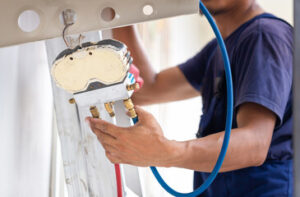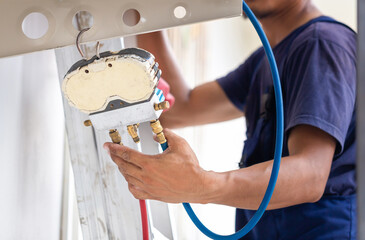The size of your air conditioner and whether you’re upgrading ductwork can significantly impact the installation time. In general, technicians will use a recovery machine to remove refrigerant from the old system and add it to the new one.
Next, they’ll set the outdoor unit on a composite pad or concrete slab. They’ll also place a protective drop cloth over the work area. Contact Air Conditioning Installation Los Angeles for professional help.
The installation process for your new air conditioner may seem long and complex, but in the hands of an experienced team it will be completed efficiently and thoroughly. This will ensure that your AC is properly sized and installed, so it provides the cooling capacity your home needs without overtaxing the system or causing it to work too hard, increasing your utility bills.
The first step is to determine what type of air conditioning system your home needs. This involves evaluating your current insulation, the number of west-facing windows, and other factors that can impact the efficiency of an AC unit. Using this information, the installer will recommend what size and model of air conditioner is ideal for your home.
Once the new air conditioner is purchased, a professional will schedule a time to arrive and begin the installation process. Before the team arrives, they should communicate with you to share important details about the process, including what steps will be required and how long the installation should take.
Before beginning, the team will inspect your home’s ductwork and make any necessary repairs or upgrades to ensure it is functioning properly. They will also verify that any necessary permits have been obtained. The team will then remove the old AC unit from your home, disconnect any electrical wiring, and clean up the area around the unit.
The next step is to install the line set for your new air conditioning. The installer will push unrolled sections of line through a hole (between 2″ and 2.5″) in the outside wall, near the air conditioner. Just enough line is pushed through to reach the service valve for the unit.
Outdoor Unit
The outdoor unit (also known as the condenser) is one of the most important parts of your AC system. Its job is to release the heat absorbed by the refrigerant into the outdoors, something that cannot happen without it.
The condenser unit is located outside your home and houses a compressor, condenser coil, and fan. The compressor pressurizes the refrigerant, which then moves to the outdoor coil and absorbs the heat from the air in your home. The absorbed heat causes the refrigerant to change from a liquid into a gas. It then returns to the compressor to be repressurized, and the cycle begins again.
It’s important to have the outdoor unit in a shaded area to prevent sun damage and dirt accumulation. Additionally, it’s best to install the unit on a composite pad rather than a concrete pad, as concrete can crack and become unstable over time.
If the outdoor unit is too close to a bedroom, it may cause loud noises and disrupt your sleep. It is also a good idea to have the unit placed away from any shrubs, trees, or other structures that could block airflow to the condenser unit.
If your outdoor unit is causing problems, you should contact an HVAC technician right away to schedule repair services. It’s important to have your AC system working correctly so that you can enjoy cool and comfortable air for years to come. If the unit is nearing the end of its expected lifespan, if it requires frequent repairs, or if it is not compatible with your cooling needs, it may be time to consider a replacement. Consult with an experienced HVAC professional for recommendations that suit your needs and budget.
Indoor Unit
The indoor unit is the other half of your air conditioning system. Also known as an air handler, it’s located inside of your home, typically above the furnace or in a closet. The air handler contains the evaporator coil and blower fan that cools your home by drawing air in through the ducts, passing it over the evaporator coil, cooling and dehumidifying it, and then circulating it back out through the vents. A ductless system also has an indoor unit with a heat exchange coil, and these are the most popular cooling systems for homes because they are relatively easy to install and can be controlled by a remote.
The air handler should be placed in a well-ventilated area that is not directly exposed to sunlight, and it should have access to electricity. The indoor air conditioner is powered by a small low-voltage control wire that connects to the thermostat and communicates with the outdoor unit. The air handler should be positioned so that the evaporator coil can easily be cleaned. This will help maintain the system’s efficiency and prevent it from malfunctioning.
In addition to choosing the right size air conditioning unit for your home, you should talk with your technician about energy efficiency, as expressed by the seasonal energy efficient rating (SEER). A higher SEER rating will cost more upfront but can save you money in the long run by using less energy.
Once the installation is complete, the licensed technician will disconnect the refrigerant lines and make sure that they are properly recovered and stored. They will also check for proper electrical wiring and a safe disconnect box nearby. Anyone who handles the refrigerant must have an EPA certification to do so.
Thermostat
A thermostat is a device that turns your air conditioning system’s fan and compressor on and off based on indoor temperatures. It has a hot and cold wire, a common wire, a fan blower wire, and two or more wires for things like auxiliary heat, emergency heat, and two-stage heating and cooling. The thermostat also has a sensor that reads your home’s temperature.
Most homes have a single thermostat located in the living room or other centrally-located room. The thermostat is important for both home comfort and energy efficiency because it controls how often the AC runs and sets your desired temperature. Thermostats can also be programmed to learn your family’s preferred heating and cooling habits. They can adjust themselves to save energy, and they can also detect any problems with the air conditioner equipment so you’ll get a notification if there is an issue.
The location of a thermostat is very important, because it determines how accurate the device is. It’s important to keep the device away from heat sources, such as lamps, televisions, and kitchen appliances, because they can cause inaccurate temperature readings. In addition, it’s recommended to place the thermostat at an ideal height—52-60 inches above floor level. This ensures that you’ll be able to comfortably reach the device to make any necessary adjustments.
Before installing the new thermostat, you’ll need to remove the old one by unscrewing its wall plate and removing the screws that hold it to the wall. Next, you’ll need to turn off the furnace and air conditioning breakers in your electric panel. Once you’ve done this, you can remove the front faceplate of the old thermostat and look for a wire attached to a terminal labeled “C,” which is the c-wire.
Ductwork
The ductwork is where the actual air conditioning work happens, as it is the network of lines that distributes conditioned air throughout your home. It works by having air sucked into the furnace, heated or cooled and then pushed back out into the rooms through different return vents in your home. Without ducts, every room would have a different temperature and your energy bills would be much higher than they are now.
When ducts are in good condition, they should be relatively quiet. But if they become clogged it will cause whistling sounds as air passes through them. It’s important to have them inspected periodically to make sure they aren’t leaking. Also, if there is a musty or stale odor coming from the supply air ducts it may be due to mold growth inside the ducts.
Ducts can be made of a variety of materials and are typically installed in a suspended ceiling or hidden in the attic. They can be flexible insulated ducts, rectangular metal ducts or spiral metal ducts. The type used will depend on what the building needs to be used for.
An air handler unit (AHU) connects to the ductwork and houses the blower, heating and cooling elements as well as filters. It can be fitted with dampers (to control the flow of air), smoke or fire dampers and a plenum to collect condensation from the AHU.
If you have a problem with your ductwork, an HVAC professional is likely to be able to repair it much sooner than you could on your own. They will be able to identify the problem, come up with a plan and then put that plan into action to fix it.

